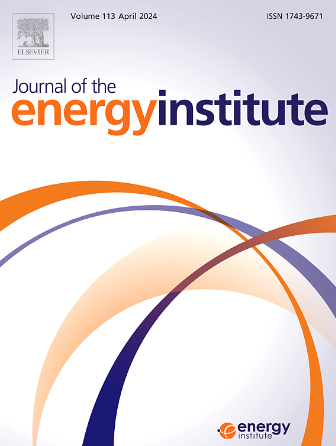垃圾处理等离子气化系统预热温度与电极消耗的研究
IF 6.2
2区 工程技术
Q2 ENERGY & FUELS
引用次数: 0
摘要
鉴于目前废物管理方面的挑战和现有常规技术的限制,需要对加强废物处理设施进行全面研究。本研究的重点是优化操作参数,以达到850°C的预热温度,这是有效处理废物的关键阈值。在250 A和300 A电压范围为25-35 V的各种载气下进行了实验,以分析一小时内的腔室温度曲线,并确定最小功耗的合适载气。载气为氩气、氮气、空气以及氩气-氮气和氩气-空气的混合物。确定的优化情况包括氩等离子体(15 LPM, 300A),在16分钟内达到850°C,功耗为1.95 kW;空气等离子体(15 LPM, 300 A)在20分钟内达到,消耗2.33 kW,氩气-空气等离子体(10 LPM &;5 LPM, 300A), 20分钟,2.23 kW。此外,一项电极消耗研究评估了其长期运行可行性。氩气-氮气等离子体的电极消耗最低(阳极为9 g/h,阴极为3 g/h),而氩气等离子体的电极消耗最高(阳极为66 g/h,阴极为48 g/h)。本文章由计算机程序翻译,如有差异,请以英文原文为准。

Study of preheating temperature and electrode consumption in a plasma gasification system for waste processing
Given the present challenges in waste management and the constraints of existing conventional technologies, comprehensive research into enhanced waste treatment facilities is needed. This study focuses on optimizing the operational parameters necessary to achieve a preheating temperature of 850 °C, a critical threshold for effective waste treatment. The experiments are carried out for various carrier gases at 250 A and 300 A with a voltage range of 25–35 V to analyse chamber temperature profiles over an hour and identify the suitable carrier gas for minimal power consumption. The carrier gases are argon, nitrogen, air, and mixtures such as argon-nitrogen and argon-air. The optimized cases identified include argon plasma (15 LPM, 300A), achieved 850 °C in 16 min with a power consumption of 1.95 kW; air plasma (15 LPM, 300 A), attained in 20 min, consuming 2.33 kW, and argon-air plasma (10 LPM & 5 LPM, 300A) in 20 min with 2.23 kW. Also, an electrode consumption study assesses its long-term operational feasibility. The lowest electrode consumption is observed with argon-nitrogen plasma (9 g/h for anode and 3 g/h for cathode), while argon-air plasma exhibited the highest (66 g/h for the anode and 48 g/h for the cathode).
求助全文
通过发布文献求助,成功后即可免费获取论文全文。
去求助
来源期刊

Journal of The Energy Institute
工程技术-能源与燃料
CiteScore
10.60
自引率
5.30%
发文量
166
审稿时长
16 days
期刊介绍:
The Journal of the Energy Institute provides peer reviewed coverage of original high quality research on energy, engineering and technology.The coverage is broad and the main areas of interest include:
Combustion engineering and associated technologies; process heating; power generation; engines and propulsion; emissions and environmental pollution control; clean coal technologies; carbon abatement technologies
Emissions and environmental pollution control; safety and hazards;
Clean coal technologies; carbon abatement technologies, including carbon capture and storage, CCS;
Petroleum engineering and fuel quality, including storage and transport
Alternative energy sources; biomass utilisation and biomass conversion technologies; energy from waste, incineration and recycling
Energy conversion, energy recovery and energy efficiency; space heating, fuel cells, heat pumps and cooling systems
Energy storage
The journal''s coverage reflects changes in energy technology that result from the transition to more efficient energy production and end use together with reduced carbon emission.
 求助内容:
求助内容: 应助结果提醒方式:
应助结果提醒方式:


